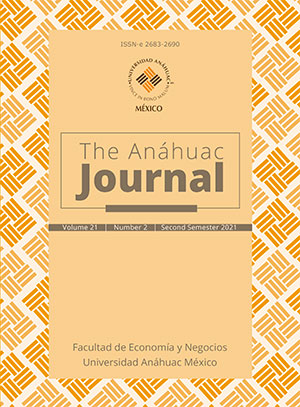The global avocado market: 60 years of Mexico’s leadership and its impact on the next decade
Main Article Content
Abstract
This research studies Mexico’s leadership for 60 years (1961-2019) in the production and worldwide market of avocado. The Pearson’s Correlation analysis of the variables that make up the market — supply (production), demand (consumption) and price — verifies that the correlation of the variables is «high» and «direct», however it is not «perfect», demonstrating that in the medium or long term the profitability of the business will be affected by the lack of a proportional dynamic between the three variables (the trend of the increase in the volume of production is greater than the demand). It is verified that the supply determines the rise or fall in the price of the product (Smith, 1776, n/d), and that in the absence of a coordinated strategy of the avocado sector in Mexico, the income of the national producer will be systematically reduced until the market finds its point of equilibrium.
Downloads
Article Details

This work is licensed under a Creative Commons Attribution-NonCommercial-ShareAlike 4.0 International License.
This work is licensed under a Creative Commons Atribución-NoComercial-CompartirIgual 4.0 Internacional.
References
Asociación de Productores y Empacadores de Aguacate de Michoacán (APEAM). (2 de diciembre de 2020). «Producción de aguacate en México». http://www.apeamac.com
Bosch García, C. (2003). La técnica de la investigación documental. (12.a ed.). Editorial Trillas. 143 pp.
Cohen, J. (1988). Statistical power analysis for the behavioral sciences. (2.a ed.). New York University.
Consejo Nacional de Productores de Aguacate (Conapa) y Comité Nacional del Sistema Producto AGUACATE, A.C. (Conasipro). (22 de septiembre de 2020). «Productores de aguacate». Modula Revista. http://www.productoresdeaguacate.com/MODULArevista/modulos/web/www/index.php
Cruz, P.C. (7 de febrero de 2018). «Producción e intercambio comercial del aguacate mexicano». El Economista. https://www.eleconomista.com.mx/opinion/Produccione-intercambio-comercial-del-aguacate-mexicano-I-20180207-0137.html
Escamilla, G. (1996). Manual de metodología y técnicas bibliográficas. (3.ª ed.). UNAM.
«Estados Unidos levanta la veda a frutas y vegetales de República Dominicana». (17 de diciembre de 2017). Agencia EFE. https://www.efe.com/efe/america/economia/estados-unidos-levanta-la-veda-a-frutas-y-vegetales-de-republica-dominicana/20000011-3469808
Estrada, C. (15 de febrero del 2020). «El apetito voraz de aguacates». La Jornada del campo.
https://www.jornada.com.mx/2020/02/15/delcampo/articulos/apetito-voraz.html
Guevara, W., Hidalgo-Alcázar, C. y Rojas, J. L. (2021). «Análisis de la agroindustria chilena del aguacate (palta) en el mercado internacional». Chilean Journal of Agricultural & Animal Sciences, 37 (1), 54-64. https://revistas.udec.cl/index.php/chjaas/article/view/3768
Johnson, B. y Onwuegbuzie, A. (2004). «Mixed Methods Research: A Research Paradigm
Whose Time Has Come». Educational Researcher. 2004, 33 (7), 14-26. https://doi.org/10.3102/0013189X033007014
Ley del Mercado de Valores. (2020). https://www.pld.hacienda.gob.mx/work/models/
uif/librerias/documentos/mj /Ley_del_Mercado_de_Valores.pdf
Martínez, M. del P. (31 de enero de 2018). «Productor principal de aguacate en México».
El Economista. https://www.eleconomista.com.mx/empresas/Mexico-principalproductor-de-aguacate-20180131-0111.html
Minitab. (s/f). Herramientas estadísticas, de análisis de datos y de mejora de procesos.
Recuperado el 4 de octubre de 2020 de https://www.minitab.com/es-mx/
Organización de las Naciones Unidas para la Alimentación y la Agricultura (FAO). (2020).
Producción mundial de aguacate (base de datos). http://www.fao.org/faostat/es
Pardinas, F. (1999). Metodología y técnicas de investigación en ciencias sociales. Siglo XXI Editores.
Pérez Porto, Julián y Ana Gardey (2017). Definición de correlación, https://definicion.de/correlacion
Sistema de Información Agroalimentaria y Pesquera (SIAP). (2020). Información Estadística
Agropecuaria de México (base de datos). https://www.gob.mx/siap
Smith, A. (1776, s/f). La riqueza de las naciones (trad. C.R. Braun). Secretaría de Educación Coahuila. http://web.seducoahuila.gob.mx/biblioweb/upload/1 %20La %20riqueza %20de %20las %20Adam %20Smith.pdf
Wayne, W. D. (1990). Estadística con aplicaciones a las ciencias sociales y a la educación. McGraw Hill.

